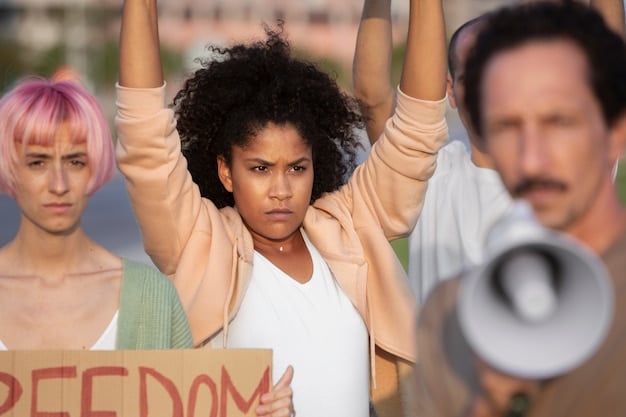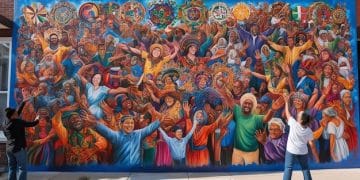Juneteenth: Cultural Significance, Commemorations & Celebrations Across US

Advertisements
Juneteenth, commemorating the emancipation of enslaved African Americans, holds profound cultural significance across the US through diverse commemorations and celebrations that reflect its historical journey and ongoing impact on American identity.
Exploring the Cultural Significance of Juneteenth: Commemorations and Celebrations Across the US offers a profound journey into America’s complex historical landscape, marking the emancipation of enslaved African Americans and celebrating freedom. This pivotal day, often misunderstood or overlooked, embodies a narrative of resilience, hope, and continued struggle for justice, weaving itself into the very fabric of the nation’s cultural tapestry.
The Historical Roots of Juneteenth: A Defining Moment
Juneteenth, observed annually on June 19th, marks the day in 1865 when Union soldiers arrived in Galveston, Texas, announcing the end of the Civil War and the freedom of enslaved African Americans. This momentous occasion occurred more than two years after President Abraham Lincoln issued the Emancipation Proclamation. For many, it was the true realization of freedom, transforming a legal decree into a lived reality.
The delay in Texas was largely due to the limited presence of Union troops, allowing slaveholders to maintain control and even expand slavery despite the Proclamation. When Major General Gordon Granger arrived with federal troops, General Order No. 3 was read, stating that “all slaves are free.” This declaration not only freed the last enslaved people but also solidified Juneteenth as a powerful symbol of emancipation and a turning point in American history.
Deepening Understandings of Emancipation
Understanding Juneteenth requires acknowledging the uneven and protracted process of emancipation. While the Emancipation Proclamation was issued in January 1863, its enforcement was contingent on Union military control. Texas, geographically distant and largely untouched by direct warfare until late in the conflict, became a refuge for slaveholders migrating from other Southern states to escape the Union advance, bringing their enslaved people with them. This created a heightened concentration of enslaved individuals in Texas, making the news of their freedom on June 19, 1865, particularly impactful.
- The Emancipation Proclamation freed enslaved people in Confederate states not under Union control.
- Texas held the largest number of enslaved people in the Confederacy by 1865.
- June 19, 1865, brought belated freedom to approximately 250,000 enslaved people in Texas.
The historical context also highlights the long and arduous fight for civil rights that continued long after Juneteenth. The jubilation of freedom was soon confronted by the realities of Reconstruction, Jim Crow laws, and persistent systemic inequalities. Thus, Juneteenth serves as a reminder not just of a historical event, but of an ongoing journey towards full equality and justice for Black Americans.
The immediate aftermath of General Order No. 3 saw a mixture of confusion, disbelief, and overwhelming joy among the newly freed. Many left plantations immediately, seeking family members or opportunities elsewhere, while others stayed to negotiate new terms of labor under vastly different circumstances. This day, therefore, represents a pivotal break from the brutal institution of slavery, even as its legacy continues to shape the American experience.
Evolving Traditions: From Local Observance to National Holiday
For decades after 1865, Juneteenth remained primarily a regional observance, especially strong in Texas and neighboring states. Early celebrations featured spiritual readings, food, music, and storytelling, often held in designated “Emancipation Parks.” These gatherings served as vital community anchors, celebrating freedom while also reinforcing cultural ties and resilience in the face of post-Reconstruction adversity.
The Great Migration, beginning in the early 20th century, saw millions of African Americans move from the Southern states to the North, Midwest, and West. As they migrated, they carried their traditions, including Juneteenth observances, with them, gradually spreading awareness and celebration of the holiday across the nation. Despite this spread, Juneteenth largely remained outside mainstream historical narratives for much of the 20th century.
Waves of Recognition and Activism
The Civil Rights Movement of the mid-20th century brought renewed attention to Black history and heritage, and Juneteenth began to gain broader recognition. Activists and educators emphasized its importance as a symbol of emancipation and a testament to the perseverance of African Americans. Various states began to formally recognize Juneteenth over time, though progress was slow and fragmented.
- Texas officially recognized Juneteenth as a state holiday in 1980.
- Grassroots efforts and community organizers played a crucial role in advocating for wider recognition.
- The Black Lives Matter movement further propelled Juneteenth into national consciousness.
The push for federal recognition intensified in the late 20th and early 21st centuries. In 2020, amidst widespread protests for racial justice following the murder of George Floyd, public and political momentum for establishing Juneteenth as a federal holiday reached an unprecedented level. This momentum reflected a broader societal awakening to systemic racial inequalities and a desire to acknowledge historical injustices.
On June 17, 2021, President Joe Biden signed the Juneteenth National Independence Day Act into law, making Juneteenth a federal holiday. This historic act solidified its place alongside other major national observances, affirming its significance not only for African Americans but for all Americans as a day to reflect on freedom, equality, and the nation’s journey towards a more perfect union. The federal recognition marked a profound shift, transforming a long-held regional tradition into a moment of national reckoning and celebration.
Commemorations Across the US: A Tapestry of Expression
Juneteenth commemorations across the United States are as diverse as the communities that observe them, reflecting a rich tapestry of cultural expression, historical remembrance, and forward-looking activism. While core themes of freedom and resilience remain constant, the forms these celebrations take vary considerably from parades and festivals to educational seminars and artistic performances.
In the South, particularly in Texas, traditional celebrations often include historical reenactments, gospel music, and shared meals featuring classic Juneteenth foods like red velvet cake, symbolizing the bloodshed and sacrifice of the enslaved. These events frequently center around churches and community centers, fostering a strong sense of communal identity and historical continuity.
Regional Variations and Local Flavors
Each region contributes its unique flavor to Juneteenth celebrations. In the Midwest and Northeast, where large populations of African Americans settled during the Great Migration, Juneteenth events often blend historical reflection with contemporary cultural showcases. Cities like Chicago, Detroit, and New York host large-scale festivals with live music, artisan markets, and family-friendly activities, drawing diverse crowds.
- West Coast: Emphasis on social justice and artistic expression, with spoken word, murals, and community dialogues.
- Mid-Atlantic: Focus on educational programming and historical tours, often linking local abolitionist history with Juneteenth.
- Rural Communities: Smaller, intimate gatherings, often centered on picnics, family reunions, and shared history.

In many urban centers, Juneteenth has become an opportunity for large-scale public engagement. Parades featuring marching bands, community groups, and floats often wind through city streets, culminating in outdoor concerts or cultural festivals that last for hours, sometimes days. These events are not just celebrations; they are also platforms for dialogue about ongoing racial issues and calls for continued progress.
Academic institutions and museums also play a significant role. Many host lectures, exhibitions, and workshops explaining the historical context and contemporary relevance of Juneteenth. These educational initiatives ensure that the meaning of the holiday is deeply understood, moving beyond mere celebration to foster critical reflection on American history and its implications for the present. The variety of these commemorations underscores the holiday’s universal appeal and its adaptability to different local contexts, while always retaining its profound core message of liberty and justice for all.
The Symbolism of Red: Food, Drink, and Garments
One of the most striking visual elements of Juneteenth celebrations is the pervasive use of the color red. This is not coincidental; the color carries deep symbolism, representing the resilience and ingenuity of enslaved African Americans, and often, the bloodshed and sacrifice endured on the path to freedom. This symbolism is woven into various aspects of the celebration, from traditional foods to decorative elements.
Traditional Juneteenth foods often feature red ingredients. Red velvet cake is a staple, its deep crimson hue a direct nod to the symbolic color. Similarly, red drinks like hibiscus tea (often called “sorrel” or “red drink”), fruit punch, and strawberry soda are common. These beverages are not just refreshing; they connect back to traditional West African drinks brought to the Americas, further emphasizing the cultural heritage of the celebration.
Culinary Traditions and Cultural Heritage
The culinary traditions of Juneteenth are central to its observance, serving as a tangible link to the past and a means of cultural preservation. The preparation and sharing of food are communal acts that reinforce family bonds and community ties, while also educating younger generations about their heritage.
- Barbecue: A popular choice, symbolizing self-sufficiency and the ability to feast on one’s own terms.
- Watermelon: Often present at gatherings, embodying the bounty of summer and traditional African American agricultural practices.
- Sweet Potato Pie: Another dessert often enjoyed, connecting to Southern culinary traditions adapted by Black communities.
Beyond food, red garments and decorations are frequently seen. Attendees might wear red clothing, and party decorations often incorporate red balloons, streamers, and tablecloths. This visual emphasis on red serves as a powerful reminder of the journey from enslavement to freedom, honoring the sacrifices made and celebrating the hard-won liberty. It also creates a cohesive visual identity for the holiday, making it instantly recognizable and impactful.
The symbolism of red also extends to the resilience of spirit. Despite the brutal conditions of slavery, African Americans maintained rich cultural practices, often adapting pre-existing traditions and creating new ones. The red food and drink, therefore, are not merely festive elements but powerful cultural markers that celebrate endurance, survival, and the vibrant continuity of Black heritage. They are a delicious and deeply meaningful part of the Juneteenth experience, connecting present generations to the struggles and triumphs of their ancestors.
Juneteenth and the Ongoing Fight for Justice
While Juneteenth marks a historical achievement of emancipation, its contemporary observance is deeply intertwined with the ongoing fight for racial justice and equality in the United States. The holiday serves as a powerful reminder that freedom, for many African Americans, remains an aspiration that has not yet been fully realized. Celebrations frequently incorporate elements of advocacy, education, and calls for systemic change.
Many Juneteenth events feature speakers, panels, and workshops dedicated to current social justice issues. Topics range from police reform and voting rights to economic inequality and educational disparities. These discussions transform Juneteenth from a purely retrospective holiday into a dynamic platform for addressing persistent challenges and mobilizing for future progress. It recognizes that while physical chains were broken, invisible barriers continue to impede true equity.
Beyond Celebration: Education and Advocacy
The educational component of modern Juneteenth commemorations is paramount. Organizers aim to inform not only African American communities but also the broader public about the historical significance of the day and its relevance to contemporary racial issues. This includes debunking myths about emancipation and highlighting the systemic nature of racial injustice that continues to exist.
- Voter Registration Drives: Common at Juneteenth events, encouraging civic participation.
- Discussions on Reparations: Emerging as a topic at some Juneteenth gatherings, reflecting calls for redress for historical injustices.
- Mentorship Programs: Often linked with Juneteenth, fostering leadership and opportunity within the Black community.

Juneteenth also provides an opportunity for introspection and solidarity. It encourages non-Black individuals to reflect on their roles in dismantling systemic racism and to engage in meaningful allyship. The holiday’s federal recognition has amplified this aspect, compelling a national conversation about America’s past and its implications for its future as a truly inclusive society.
In essence, Juneteenth is a double celebration: it commemorates a historical moment of liberation while simultaneously affirming the need for continued vigilance and advocacy. It is a day of joy, pride, and cultural affirmation, but also a solemn reminder of the work that remains to be done to achieve full freedom and justice for all. The spirit of Juneteenth, therefore, is not merely about remembrance; it is about ongoing transformation and the relentless pursuit of a more equitable world.
Juneteenth’s Impact on Modern American Identity
The federal recognition of Juneteenth as a national holiday in 2021 marked a pivotal moment in shaping modern American identity. This act formally elevated a key event in African American history to national prominence, compelling all Americans to acknowledge a more complete and complex narrative of the nation’s past. It signals a collective effort to reckon with the legacy of slavery and its enduring impact on society.
Juneteenth encourages a deeper understanding of American history, moving beyond a simplified narrative of freedom to embrace the nuanced and often painful realities of the post-Civil War era. It provides an opportunity for national reflection on the ideals of liberty and justice for all, and how far the nation has come, and how much further it still needs to go, in living up to those ideals.
Shaping Education and Public Discourse
With its new status, Juneteenth is increasingly influencing educational curricula and public discourse. Schools are developing more comprehensive lessons on the history of slavery and emancipation, incorporating Juneteenth into their teaching. This ensures that younger generations understand this crucial chapter of American history and its contemporary relevance.
- Curriculum Development: More robust inclusion of African American history in schools.
- Workplace Recognition: Companies and organizations observe Juneteenth, often with educational initiatives for employees.
- Increased Media Coverage: Greater attention to the holiday, fostering broader public awareness and understanding.
The holiday also serves as a catalyst for dialogue about race, reconciliation, and national unity. By openly acknowledging historical injustices, Juneteenth facilitates a more honest conversation about racial healing and the pursuit of a society where systemic inequalities are dismantled. It promotes a sense of shared responsibility for shaping a more just future.
Ultimately, Juneteenth is helping to reshape what it means to be an American. It expands the nation’s collective memory, incorporating a history that was long marginalized. By centering the experiences and contributions of African Americans, Juneteenth enriches the national narrative, fostering a more inclusive and accurate understanding of American identity—one that acknowledges both the triumphs and the ongoing challenges in the pursuit of a truly free and equal society for all its citizens.
| Key Aspect | Brief Description |
|---|---|
| 📖 Historical Significance | Commemorates the 1865 emancipation of enslaved people in Texas, marking the true end of slavery in the US. |
| 🇺🇸 National Recognition | Became a federal holiday in 2021, signifying its importance to American history and identity. |
| 🎉 Celebrations & Culture | Features diverse celebrations including parades, music, red-themed foods, and educational events. |
| ⚖️ Ongoing Advocacy | Serves as a platform for discussions on racial justice, equality, and systemic change. |
Frequently Asked Questions About Juneteenth
▼
Juneteenth commemorates June 19, 1865, when Union General Gordon Granger arrived in Galveston, Texas, and announced the end of slavery, effectively freeing the last remaining enslaved African Americans in the Confederate states, more than two years after the Emancipation Proclamation was issued.
▼
The color red in Juneteenth celebrations symbolizes the bloodshed and sacrifice endured during slavery and the journey to freedom. It is present in traditional foods like red velvet cake and drinks like hibiscus tea, connecting to West African culinary traditions and celebrating the resilience of the enslaved people.
▼
Initially a regional celebration primarily in Texas, Juneteenth spread with the Great Migration. Decades of grassroots activism and increased awareness, especially during renewed calls for racial justice, led to its federal recognition in 2021, cementing its place as a national day of remembrance and celebration.
▼
Juneteenth celebrations typically include parades, festivals with music and food, historical reenactments, educational seminars, and community gatherings. Many events also incorporate elements of social justice advocacy, discussions on current racial issues, and voter registration drives, blending celebration with reflection.
▼
Juneteenth’s federal recognition prompts a more inclusive understanding of American history, acknowledging the full narrative of freedom and its complexities. It fosters national dialogue on race, equality, and ongoing systemic issues, encouraging reconciliation and a shared commitment to building a more just and equitable society for all.
Conclusion
Exploring the Cultural Significance of Juneteenth: Commemorations and Celebrations Across the US reveals a holiday that is far more than just a date on the calendar; it is a living testament to resilience, a beacon of hope, and a powerful call to action. From its historical roots in Galveston to its status as a federal holiday, Juneteenth encapsulates the enduring struggle for freedom and justice. Its diverse commemorations, rich symbolism, and deep connection to ongoing social justice movements emphasize its vital role in shaping a more honest and inclusive American identity. As the nation continues to grapple with its past and strive for a more equitable future, Juneteenth stands as a profound reminder of the promises yet to be fully realized and the continuous journey towards true liberty for all.





